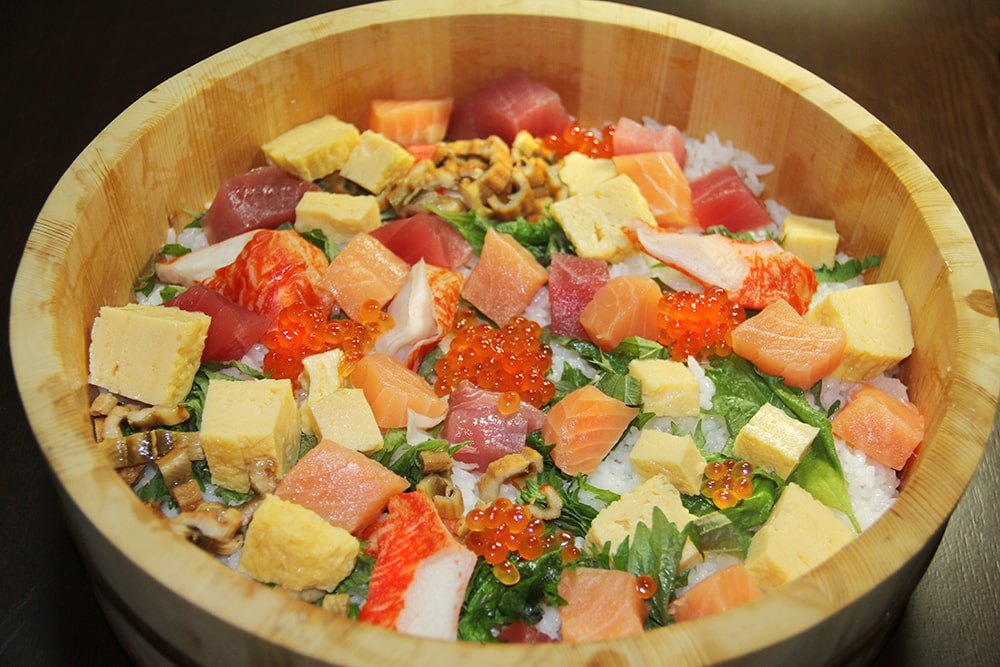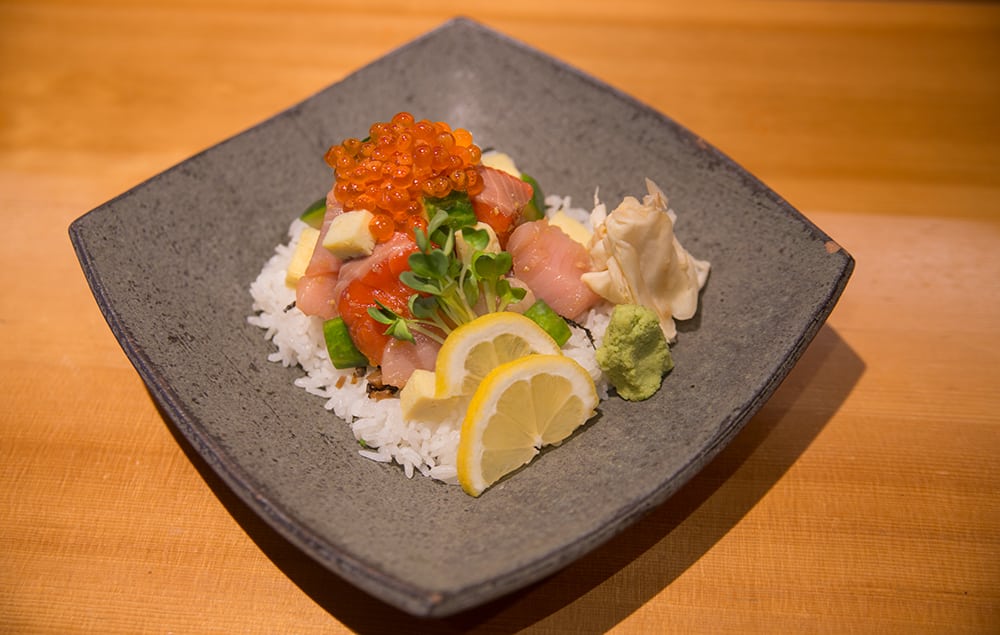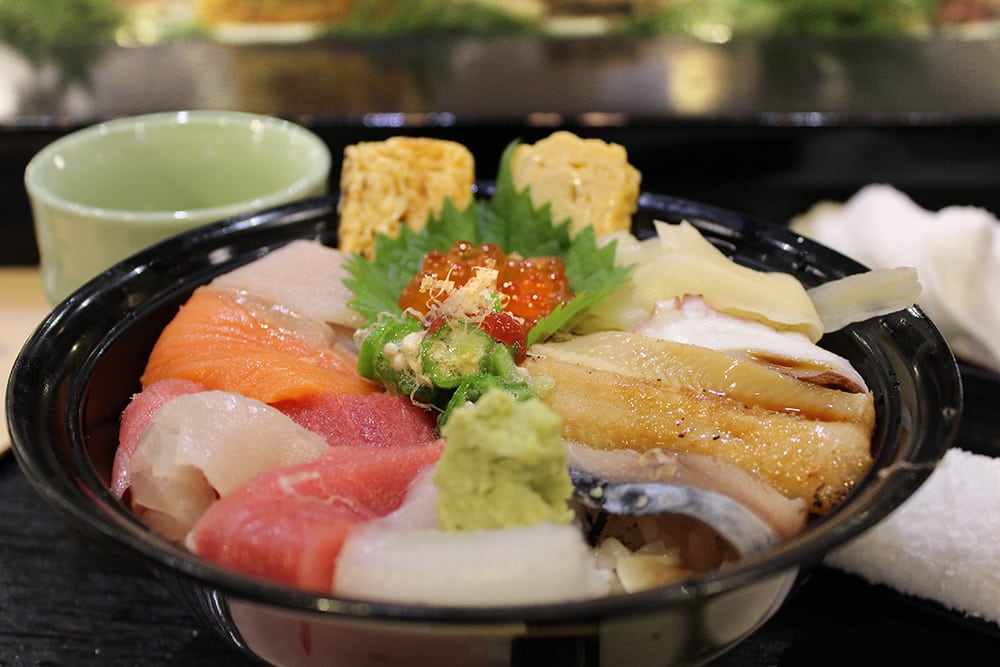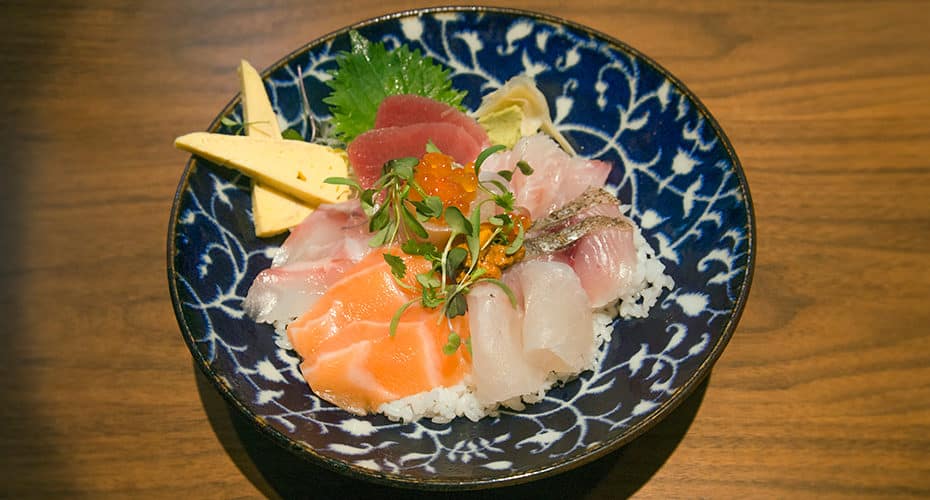Chirashi sushi is an entire sushi experience in a bowl or box. If you’ve seen it on a menu and wondered what it is, you’re in the right place.
This post will break down chirashi sushi, its main variations, and some similar dishes that are also worth trying.
Chirashi 101
Chirashi, or chirashizushi (ちらし寿司), is a classic style of sushi. It’s a bed of sushi rice and ingredients “scattered” over the top in a decorative manner. Tamago, shiitake, kanpyo, and oboro are common ingredients. Raw fish is also a popular topping.
Chirashi is often packed into a shallow rectangular or circular lacquerware box.
This chirashizushi post is part of an informative sushi and sashimi guide. Check it out and take your sushi game pro.

Two Types of Chirashi
There are two principal types of chirashi. They both have a bed of seasoned (sushi) rice. But the toppings are different.
Edomae – Tokyo Style Chirashi
Edomae (Tokyo-style) chirashi sushi is probably the most popular style. It’s either a spin-off of nigiri sushi or kaisen donburi.
The toppings of this chirashi bowl include a variety of raw and cooked seafood. Tamago, oboro, kanpyo, snow peas, lotus root, and kinome are also common. Wasabi and gari are standard, as well.
Chirashi bowls with raw fish are very popular. And it’s often prepared as sushi for carryout.
Bara Chirashi Sushi
Bara chirashi is a substyle made with smaller pieces of raw, marinated seafood.

Gomoku Chirashi – Osaka Style
Gomoku (Osaka-style) chirashi has been around for hundreds of years. It’s a celebratory dish. And in Japan, it’s often made at home.
Gomoku chirashi uses cooked ingredients over sushi rice. There’s often a layer of thinly sliced tamago in between.
Boiled ebi, surimi (fish cake), lotus root, bamboo shoots, shiitake, beni shoga, and kanpyo are some of the more popular ingredients.
How to Make Chirashi Sushi
There are endless chirashi variations. One of the better recipes I’ve found is from Japanese Cooking 101. Check out their simple how-to video below.
Need help making sushi rice? Click here.
*The Japanese Bar may earn commissions on purchases made through this link.
Similar Dishes
There are a handful of dishes that are related or superficially similar to chirashi. Learn the differences below.
Kaisen Don Vs Chirashi
Kaisen don and Tokyo-style chirashi are similar in appearance. The type of rice is the primary difference. Kaisen donburi uses hot, cooked white rice. And chirashi uses room-temperature sushi rice.
Kaisen don (海鮮丼) originated in northern Japan. It was popular among fishermen. And eventually, it spread throughout Japan.
Tekka don, negitoro don, negihama don, uni don, and ikura don are popular donburi that are similar to kaisen don.
Chirashi vs Sashimi
Sashimi is raw seafood (or meat). It’s sliced thin and served without any rice. Chirashi often includes pieces of sashimi and other ingredients. These are served over sushi rice.
Chirashi vs Poke
Chirashi and poke are very similar. And both are typically served in a bowl. Poke features marinated raw fish and other ingredients over rice. It’s sort of a Hawaiin take on chirashi.
Poke means “chunk” in Hawaiian. The chunks are traditionally cubes of yellowfin or bigeye tuna. But many other ingredients are used, as well.
Poke marinades often include soy sauce and sesame oil. And onion is a common ingredient too.
Whereas chirashi typically uses short-grain sushi rice, poke isn’t restrictive. Some poke recipes call for long-grain rice, while others use short-grain sushi rice.
Overall, poke has a loose style and allows for many ingredients. Chirashi tends to be a bit more rigid, focusing on simplicity and quality of ingredients.

Frequently Asked Questions
How to Pronounce Chirashi?
What is Chirashi in English?
Chirashi (散らし) means “scattered.” This is because ingredients are scattered over a bed of sushi rice.
How to Eat Chirashi Sushi?
Chirashi is known to send Westerns after a fork or spoon. But this dish is simple to eat with chopsticks. Simply pick up a piece of sashimi or veggie, pick up a bit of rice too, and enjoy. If this is too challenging, it’s ok to grab the sashimi and rice separately. But it’s nice to chew them at the same time.
Chefs often season chirashi. And this is more likely at high-end sushi restaurants. But it pays to ask either way.
If the chirashi is unseasoned, you can pour soy sauce or a soy/wasabi mixture over the chirashi. Alternatively, keep the soy sauce on the side and dip the sashimi and other ingredients to taste.
How to Make Chirashi Sushi Rice?
Chirashi is a type of sushi and uses the same rice as nigiri and maki. Sushi rice is easy to make at home.
My former chef Taichi Kitamura breaks down his process in the video below.
As an Amazon Associate, I earn commissions on purchases made through the following links.
31 Days of Sushi
If you find this post useful or enjoyable, I suggest you check out some of the other content in my 31 Days of Sushi campaign.
Every day in August I’ll share a new piece of content. Topics are centered around nigiri and maki sushi. I include sashimi info, as well.
It’s like an omakase of sushi information!
What Do You Think About Chirashi?
Do you have a favorite type of chirashi?
Also, have you ever made chirashi at home?
Please share your thoughts by commenting below!

Tried to make my own (very unprofessional and inauthentic!) version of bara chibashi with some delicious salmon (https://lummiislandwild.com/our-seafood/6-oz-reefnet-wild-coho-salmon/) and it was delicious! Thanks for the inspiration. I bet round #2 will be even better.
Hi Dan,
I love Lummi salmon! They’re one of the few sources that are sustainably caught. With quality ingredients like that, making delicious chirashi is fairly easy.
But yeah, the hard part is making it look good! The photos in this post were chirashi made by chefs with decades of experience. Let me know how the next one goes!
Thanks,
Brad